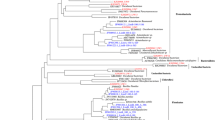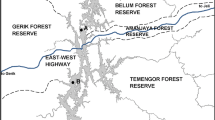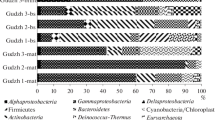Abstract
Antarctic lake ecosystems provide a rare opportunity to study the evolution and adaptation of microorganisms to extreme conditions, as well as to discover new species useful for biotechnological applications. Four water samples were collected from various layers of the water column of freshwater Lake Radok in East Antarctica. Two regions (v3-v5 and v4-v8) of the 16S rRNA gene were amplified by PCR and sequenced. Twenty dominant phylotypes were detected representing five bacterial phyla (Actinobacteria, α, β and δ Proteobacteria, Bacteroidetes, Planctomycetes, OD1) and two eukaryotic divisions (stramenopiles and green algae). Of these, 16 phylotypes demonstrated ≤98 % identity to the nearest taxa in GenBank and were therefore classified as new unknown species. Seven phylotypes demonstrated ≤90 % identity and thus remained unidentified. Actinobacteria was the most abundant phylum with 157 clones (41 % of the total number) representing 5 phylotypes. A species complex (3 clades from acI-A subgroup) of Candidatus Planktophila limnetica was prevalent in all layers. Representatives of the OD1 phylum and δ-proteobacteria were discovered by sequencing of the v3-v5 region of 16S rRNA, while Planctomycetes, β-proteobacteria and mtDNA of stramenopiles were discovered by sequencing of the v4-v8 region. This highlights the necessity of sequencing at least two 16S rRNA gene regions to gain more data on microbial community characterization. In general, despite the uniformity in the physical and chemical properties in the water column, a prominent stratification of microbial groups was observed, at the levels of both divisions and phylotypes.




Similar content being viewed by others
References
Alekhina IA, Marie D, Petit J-R, Lukin VV, Zubkov VM, Bulat SA (2007) Molecular analysis of bacterial diversity in kerosene-based drilling fluid from the deep ice borehole at Vostok, East Antarctica. FEMS Microbiol Ecol 59:289–299
Bardin VI, Piskun AA, Shmideberg NA (1990) Hydrological and hydrochemical characteristics of deep water basins in Prince Charles Mountains. Antarktika 29:97–112 (in Russian)
Bayly IAE, Gibson JAE, Wagner B, Swadling KM (2003) Taxonomy, ecology and zoogeography of two East Antarctic freshwater calanoid copepod species: Boeckella poppei and Gladioferens antarcticus. Antarct Sci 15:439–448
Bielewicz S, Bell E, Kong W, Friedberg I, Priscu JC, Morgan-Kiss RM (2011) Protist diversity in a permanently ice-covered Antarctic Lake during the polar night transition. ISME J 5:1559–1564
Bulat SA, Alekhina IA, Blot M, Petit JR, de Angelis M, Wagenbach D, Lipenkov VY, Vasilyeva LP, Wloch D, Raynaud D, Lukin VV (2004) DNA signature of thermophilic bacteria from the aged accretion ice of Lake Vostok, Antarctica: implications for searching for life in extreme icy environments. Int J Astrobiol 3:1–7
Carlson RE (1977) A trophic state index for lakes. Limnol Oceanogr 22:361–369
Chebotarev EN (2007) Bacterioplankton of Lake Radok, East Antarctica (preliminary analysis). Probl Arct Antarct 77:150–151 (in Russian)
Chuvochina MS, Marie D, Chevaillier S, Petit JR, Normand P, Alekhina IA, Bulat SA (2011) Community variability of bacteria in alpine snow (Mont Blanc) containing Saharan dust deposition and their snow colonisation potential. Microbes Environ 26:237–247
Cremer H, Gore D, Hultzsch N, Melles M, Wagner B (2004) The diatom flora and limnology of lakes in the Amery Oasis, East Antarctica. Polar Biol 27:513–531
Derz K, Klinner U et al (2004) Mycobacterium pyrenivorans sp. nov., a novel polycyclic-aromatic-hydrocarbon-degrading species. Int J Syst Evol Microbiol 54:2313–2317
Eden PE, Schmidt TM, Blakemore RP, Pace NR (1991) Phylogenetic analysis of Aquaspirillum magnetotacticum using polymerase chain reaction-amplified 16S rRNA-specific DNA. Int J Syst Bacteriol 41:324–325
Ellis-Evans JC, Laybourn-Parry J, Bayliss PR, Perriss SJ (1998) Physical, chemical and microbial community characteristics of lakes of the Larsemann Hills, Continental Antarctica. Archiv für Hydrobiol 141:209–230
Fietz S, Bleib W, Hepperle D, Koppitz H, Krienitz L, Nicklisch A (2005) A First record of Nannochloropsis limnetica (Eustigmatophyceae) in the autotrophic picoplankton from Lake Baikal. J Phycol 41:780–790
49th Russian Antarctic Expedition (2004) Report on the program of comprehensive research in the district of the Lake Radok Druznaya-4 station. St. Petersburg: FondyArkticheskogo i antarkticheskogo NII (in Russian)
50th Russian Antarctic Expedition (2006) Wintering Investigations of 2004–2006: Scientific and Technical Report), St. Petersburg: FondyArkticheskogo i antarkticheskogo NII (in Russian)
Fuchsman CA, Staley JT, Oakley BB, Kirkpatrick JB, Murray JW (2012) Free- living and aggregate-associated Planctomycetes in the Black Sea. FEMS Microbiol Ecol 80:402–416
Godon JJ, Zumstein E, Dabert P, Habouzit F, Moletta R (1997) Molecular microbial diversity of an anaerobic digestor as determined by small-subunit rDNA sequence analysis. Appl Environ Microbiol 63:2802–2813
Good IJ (1953) The population frequencies of species and the estimation of population parameters. Biometrika 40:237–264
Huang J, Swain A et al (2013) Bacterial diversity of the rock-water interface in an East Antarctic freshwater ecosystem, Lake Tawani(P)†. Aquat Biosyst 9:4
Hurlbert SH (1971) The non-concept of species diversity: a critique and alternative parameters. Ecology 52:577–586
Jezbera J, Sharma AK, Brandt U, Doolittle WF, Hahn MW (2009) Candidatus Planktophila limnetica, an Actinobacterium representing one of the most numerically important taxa in freshwater bacterioplankton. Int J Syst Evol Microbiol 59:2864–2869
Karlov DS, Marie D, Chuvochina MS, Alekhina IA, Bulat SA (2011) Microbial communities of water column of Lake Radok, East Antarctica, dominated by abundant actinobacterium “Candidatus” Planktophila limnetica. Microbiology 80:576–579
Kasalický V, Jezbera J, Šimek K, Hahn MW (2010) Limnohabitans planktonicus sp. nov. and Limnohabitans parvus sp. nov., planktonic Betaproteobacteria isolated from a freshwater reservoir, and emended description of the genus Limnohabitans. Int J Syst Evol Microbiol 60:2710–2714
Kojima H, Watanabe T, Iwata T, Fukui M (2014) Identification of major planktonic sulfur oxidizers in stratified freshwater lake. PLoS ONE 9(4):e93877. doi:10.1371/journal.pone.0093877
Krienitz L, Wirth M (2006) The high content of polyunsaturated fatty acids in Nannochloropsis limnetica (Eustigmatophyceae) and its implication for food web interactions, freshwater aquaculture and biotechnology. Limnologica 36:204–210
Krienitz L, Hepperle D, Stich H-B, Weiler W (2000) Nannochloropsis limnetica (Eustigmatophyceae), a new species of picoplankton from freshwater. Phycologia 39:219–227
Krienitz L, Bock C, Dadheech PK, Pröschold T (2011) Taxonomic reassessment of the genus Mychonastes (Chlorophyceae, Chlorophyta) including the description of eight new species. Phycologia 50:89–106
Kumar S, Nei M, Dudley J, Tamura K (2008) MEGA: a biologist-centric software for evolutionary analysis of DNA and protein sequences. Brief Bioinform 9:299–306
Lage OM, Bondoso J (2011) Planctomycetes diversity associated with macroalgae. FEMS Microbiol Ecol 78:366–375
Lauro FM, DeMaere MZ, Yau S, Brown MV, Ng C, Wilkins D, Raftery MJ, Gibson JAE, Andrews-Pfannkoch C, Lewis M, Hoffman JM, Thomas T, Cavicchioli R (2011) An integrative study of a meromictic lake ecosystem in Antarctica. ISME J 5:879–895
Lavire C, Normand P, Alekhina IA, Bulat SA, Prieur D, Birrien JL, Fournier P, Hänni C, Petit JR (2006) Presence of Hydrogenophilus thermoluteolus DNA in accretion ice in the subglacial Lake Vostok, Antarctica, assessed using rrs, cbb and hox. Environ Microbiol 8:2106–2114
Laybourn-Parry J, Marchant HJ (1992) The microbial plankton of freshwater lakes in the Vestfold Hills, Antarctica. Polar Biol 12:405–410
Laybourn-Parry J, Pearce DA (2007) The biodiversity and ecology of Antarctic lakes: models for evolution. Philos Trans R Soc B 362:2273–2289
Laybourn-Parry J, Madan NJ, Marshall WA, Marchant HJ, Wright SW (2006) Carbon dynamics in a large ultra-oligotrophic epishelf lake (Lake Beaver, Antarctica) during summer. Freshw Biol 51:1116–1130
Michaud L, Caruso C, Mangano S, Interdonato F, Bruni V, Lo Giudice A (2012) Predominance of Flavobacterium, Pseudomonas, and Polaromonas within the prokaryotic community of freshwater shallow lakes in the northern Victoria Land, East Antarctica. FEMS Microbiol Ecol 82:391–404
Newton RJ, Jones SE, Helmus MR, McMahon KD (2007) Phylogenetic ecology of the freshwater Actinobacteria acI lineage. Appl Environ Microbiol 73:7169–7176
Newton RJ, Jones SE, Eiler A, McMahon KD, Bertilsson S (2011) A guide to the natural history of freshwater lake bacteria. Mol Biol Rev 75:14–49
Parfenova VV, Gladkikh AS, Belykh OI (2013) Comparative analysis of biodiversity in the planktonic and biofilm bacterial communities in Lake Baikal. Microbiology 82:91–101
Pearce DA (2005) The structure and stability of the bacterioplankton community in Antarctic freshwater lakes, subject to extremely rapid environmental change. FEMS Microbiol Ecol 53:61–72
Pearce DA, Van der Gast CJ, Lawley B, Ellis-Evans JC (2003) Bacterioplankton community diversity in a Maritime Antarctic lake, determined by culture-dependent and culture-independent techniques. FEMS Microbiol Ecol 45:59–70
Pearce DA, Van der Gast CJ, Woodward K, Newsham KK (2005) Significant changes in the bacterioplankton community structure of a maritime Antarctic freshwater lake following nutrient enrichment. Microbiology 151:3237–3248
Pearce DA, Cockell CS, Lindstrom ES, Tranvik LJ (2007) First evidence for a bipolar distribution of dominant freshwater lake bacterioplankton. Antarct Sci 19:245–252
Petit JR, Alekhina I, Bulat S (2005) Lake Vostok, Antarctica: exploring a subglacial lake and searching for life in an extreme environment. In: Gargaud M, Barbier B, Martin H, Reisse J (eds) Lectures in astrobiology. Springer, Berlin, pp 227–288
Priscu JC, Foreman CM (2009) Lakes of Antarctica. In: Likens GE (ed) Encyclopedia of inland waters. Elsevier Press, Oxford, pp 555–566
Qu JH, Yuan HL (2008) Sediminibacterium salmoneum gen. nov., sp. nov., a member of the phylum Bacteroidetes isolated from sediment of a eutrophic reservoir. Int J Syst Evol Microbiol 58:2191–2194
Reddy Vardhan PV, Shiva Nageswara Rao SS et al (2009) Bacterial diversity and bioprospecting for cold-active enzymes from culturable bacteria associated with sediment from a melt water stream of Midtre Loenbreen glacier, an Arctic glacier. Res Microbiol 160:538–546
Rojas JL, Martín J et al (2009) Bacterial diversity from benthic mats of Antarctic lakes as a source of new bioactive metabolites. Mar Genom 2:33–41
Sokratova IN (2010) Antarctic oases: history and results of investigation. AARI, Saint-Petersburg (in Russian)
Schiaffino MR, Unrein F, Gasol JM, Farias ME, Estevez C, Balague V, Izaguirre I (2009) Comparative analysis of bacterioplankton assemblages from maritime Antarctic freshwater lakes with contrasting trophic status. Polar Biol 32:923–936
Schloss PD, Handelsman J (2005) Introducing DOTUR, a computer program for defining operational taxonomic units and estimating species richness. Appl Environ Microbiol 71:1501–1506
Villaescusa JA, Casamayor EO, Rochera C, Velásquez D, Chicote A, Quesada A, Camacho A (2010) A close link between bacterial community composition and environmental heterogeneity in maritime Antarctic lakes. Int Microbiol 13:67–77
Villaescusa JA, Casamayor EO, Rochera C, Quesada A, Michaud L, Camacho A (2013) Heterogeneous vertical structure of the bacterioplankton community in a non-stratified Antarctic lake. Antarct Sci 25:229–238
Wagner B, Cremer H (2006) Limnology and sedimentary record of Radok Lake, Amery Oasis, East Antarctica. In: Fütterer D, Damaske D, Kleinschmidt G, Miller H, Tessensohn F (eds) Antarctica. Springer, Berlin, pp 447–454
Wagner B, Seppelt R (2006) Deep-water occurrence of the moss Bryum pseudotriquetrum in Radok Lake, Amery Oasis, East Antarctica. Polar Biol 29:791–795
Williamson KE, Kan J, Polson S, Williamson S (2011) Optimizing the indirect extraction of prokaryotic DNA from soils. Soil Biol Biochem 43:736–748
Yang T, Lyons S et al (2011) Microbial communities and chemosynthesis in Yellowstone Lake sublacustrine hydrothermal vent waters. Front Microbiol 2:130. doi:10.3389/fmicb.2011.00130
Yuan M, Yu Y, Li H-R, Dong N, Zhang X-H (2014) Phylogenetic diversity and biological activity of Actinobacteria isolated from the Chukchi Shelf Marine Sediments in the Arctic Ocean. Mar Drugs 12:1281–1297
Zhang R, Wu Q, Piceno YM, Desantis TZ, Saunders FM, Andersen GL, Liu W-T (2013) Diversity of bacterioplankton in contrasting Tibetan lakes revealed by high-density microarray and clone library analysis. FEMS Microbiol Ecol 86:277–287
Acknowledgments
We would like to thank the team of the 50th Russian Antarctic Expedition and personally V.L. Kuznetsov, M.P. Andreev and A.I. Kutsuruba for lake water sampling and for transportation of frozen samples (on RV ‘Fedorov’) to Bremerhaven; LGGE (Grenoble, France) for delivery of the samples from Bremerhaven to Grenoble; and Olga Neveykina and especially Ian Probert for English language editing. We are also very grateful for the time and energy the reviewers extended to help us improve the paper. The research was partially supported by the Russian Foundation for Basic Research (RFBR), Research Project No. 07-04-00646, as well as the Act 211 Government of the Russian Federation, Agreement No. 02.A03.21.0006.
Author information
Authors and Affiliations
Corresponding authors
Rights and permissions
About this article
Cite this article
Karlov, D.S., Marie, D., Sumbatyan, D.A. et al. Microbial communities within the water column of freshwater Lake Radok, East Antarctica: predominant 16S rDNA phylotypes and bacterial cultures. Polar Biol 40, 823–836 (2017). https://doi.org/10.1007/s00300-016-2008-9
Received:
Revised:
Accepted:
Published:
Issue Date:
DOI: https://doi.org/10.1007/s00300-016-2008-9




